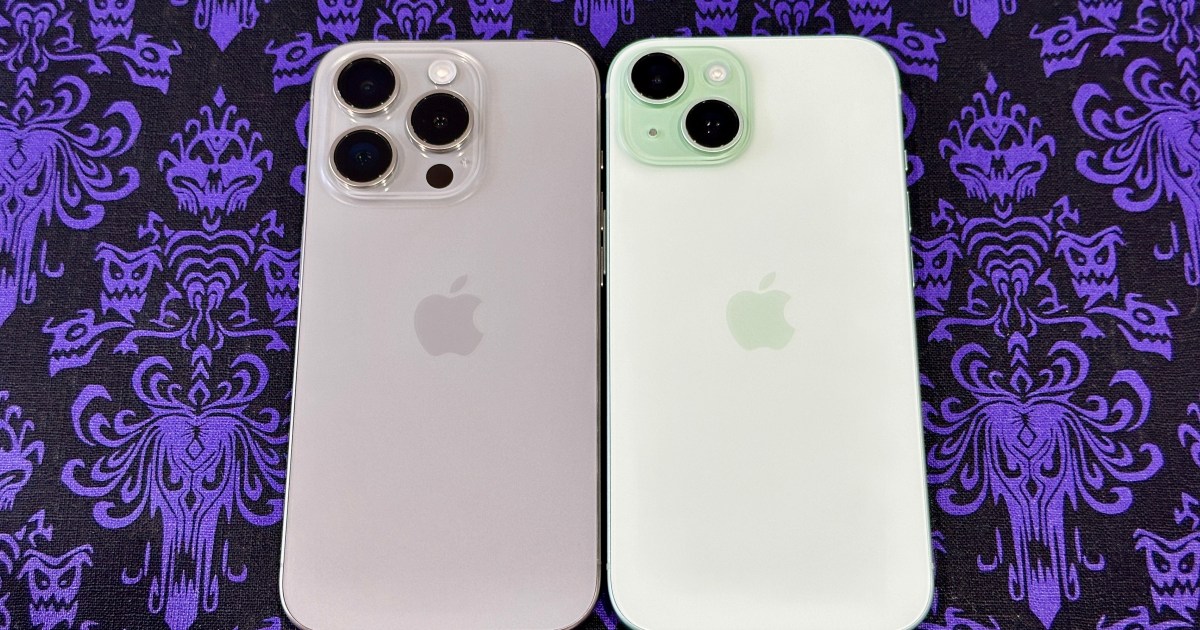Apple’s iPhone has been around for well over a decade now, and it’s always a great choice for those who are looking for a smartphone. For years, there was only one iPhone model to choose from, so your only decision was how much capacity to get and whether you wanted it with a darker black/gray or a lighter white/silver finish. Today, the latest iPhone models come in multiple versions, making the choice between them a bit more complicated.
For example, the newest iPhone 15 lineup offers four different models to choose from. Plus, Apple still sells the older iPhone 14 and iPhone 13. Lastly, there’s the iPhone SE for folks looking for a small and affordable no-frills model — or those who still really like the traditional home button and Touch ID sensor.
With so many choices, which iPhone should you get? Our recommendation for most people is the iPhone 15. However, if you want to save some money, you can pick up the iPhone 14 or check out the latest iPhone deals. And if you want to see what else is out there, we have a list of best Android phones too.
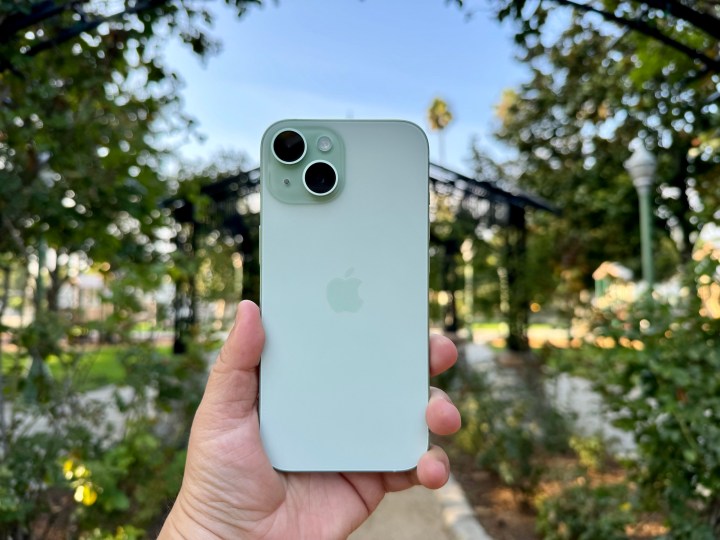
Christine Romero-Chan / Digital Trends
iPhone 15
The best iPhone for most people
Pros
- Big camera upgrade
- USB-C
- Matte glass feels incredible
- Dynamic Island
- Curved edges are more comfortable
- Reverse wired charging
Cons
- 60Hz refresh rate display
- Most color options are too light
- Can get warm when running intensive apps
Why you should buy this: Apple’s base model iPhone 15 packs in a lot of pro features such as the new 48MP main camera, Dynamic Island, A16 Bionic chip, and USB-C.
Who it’s for: Anyone who wants the latest from Apple without breaking the bank.
The iPhone 15 is the best iPhone for most people. Even though there are the more powerful Pro models available, the iPhone 15 has received significant upgrades from Apple this year.
With the iPhone 15, you still have the 6.1-inch Super Retina XDR OLED display, but this year the display reaches peak brightness of 2,000 nits outdoors. However, the refresh rate is still stuck at 60Hz, which is quite low for the price — especially when compared to Android devices. That means that scrolling won’t be as smooth as displays with higher refresh rates, like the iPhone 15 Pro, though most people won’t notice unless the devices are side by side. Still, colors are bright and vibrant on the screen, and text is still sharp and crisp. The Dynamic Island has also made its way to the base model, after launching on the iPhone 14 Pro last year.
Apple gave the iPhone 15 a surprise upgrade with the dual camera system this year, bumping the main lens from 12MP to 48MP, just like the iPhone 14 Pro last year. The default photos will be in 24MP, which means more details and slightly larger file sizea. The ultrawide camera is still 12MP with a 120-degree field of view. And the larger sensors on the iPhone 15 cameras have made it possible for the iPhone 15 to get 2x optical zoom without a telephoto lens.
There is also a new Auto Portrait feature, so any image that has the focus on a person or pet will automatically capture depth information, allowing users to turn them into portrait images after the fact.
An A16 Bionic chip, which debuted in the iPhone 14 Pro, powers the iPhone 15. That means you get blazing-fast performance with 6GB RAM and your choice of 128GB, 256GB, or 512GB storage options. With the A16 Bionic, iOS 17 runs like a dream on the iPhone 15, and there are plenty of new features to love. NameDrop makes sharing contact information easier than ever, AirDrop received improvements to make it possible to continue transferring over Wi-Fi if you go out of range, and StandBy mode turns your iPhone into a smart display when charging.
Lastly, Apple replaced Lightning with USB-C, though the charging speeds remain the same. A full charge should get you through the day without a problem. The iPhone 15 also comes in a slate of beautiful pastel colors, with pink being the standout option.

iPhone 15
The best iPhone for most people
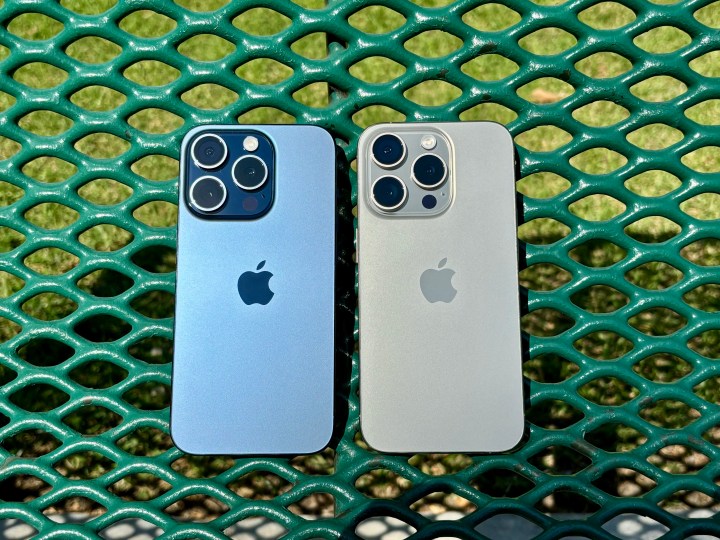
Christine Romero-Chan / Digital Trends
iPhone 15 Pro
The best premium iPhone
Pros
- Titanium makes a significant difference
- Action button is convenient
- Improved cameras
- USB-C!
- Powerful performance with A17 Pro
- Gorgeous display
Cons
- Boring colors
- Slow USB-C charging speeds
- No 5x optical zoom
- Action button limited to one gesture
Why you should buy this: It offers top performance and power, a new Action button, great cameras, and a new titanium design that actually makes a difference.
Who it’s for: Anyone who wants the absolute best from Apple while still preferring a compact form factor.
Though the base model iPhone 15 is great for most people, those who want a premium iPhone should take a look at the iPhone 15 Pro. This year, Apple has replaced the stainless steel frame of prior generations with a new brushed titanium frame, which has made the phone feel significantly lighter. There’s also more of a curve on the edges, which makes the phone feel much more comfortable to hold, as there are no more sharp edges that dig into your skin.
Though the mute/silent switch has been a part of the iPhone since the original, Apple has gotten rid of it in favor of a new Action button. With the Action button, the default setting is still to silence/mute the device, but you can also change it to something else — such as launching the camera, your flashlight, the Voice Memo app, an Accessibility setting, or even going all-in with Shortcuts. Unfortunately, the Action button is limited to a single action with a press-and-hold gesture. Hopefully, at some point, Apple can make it so that the Action button can do multiple actions with a double-press or triple-press.
Performance on the iPhone 15 Pro is a beast thanks to the A17 Pro chip that’s inside, as well as a bump in RAM to 8GB. This makes iOS 17 run better than ever on the iPhone 15 Pro, and the always-on display makes StandBy mode even more useful. There are also interactive widgets and other features in iOS 17 that make using your iPhone a breeze.
Though the iPhone 15 Pro doesn’t have the new telephoto lens of its Pro Max sibling, the triple-lens camera system is still nothing to sneeze at. You have a 48MP main camera, 12MP ultrawide, and 12MP telephoto. Auto Portrait mode is available on the iPhone 15 Pro, and the default shooting mode is in 24MP for more details. Apple’s Smart HDR 5 this year seems to have fixed most of the complaints of oversharpening and processing on the iPhone 14 series and prior models, as colors are more realistic and not super harsh and washed-out.
And while Apple switched to USB-C from Lightning, the charging speeds are still the same. But the iPhone 15 Pro has faster data transfer speeds than the standard iPhone 15 models, in case you plug your phone into your computer to transfer photos and video. A full charge of the iPhone 15 Pro should get you through the day without a problem.

iPhone 15 Pro
The best premium iPhone
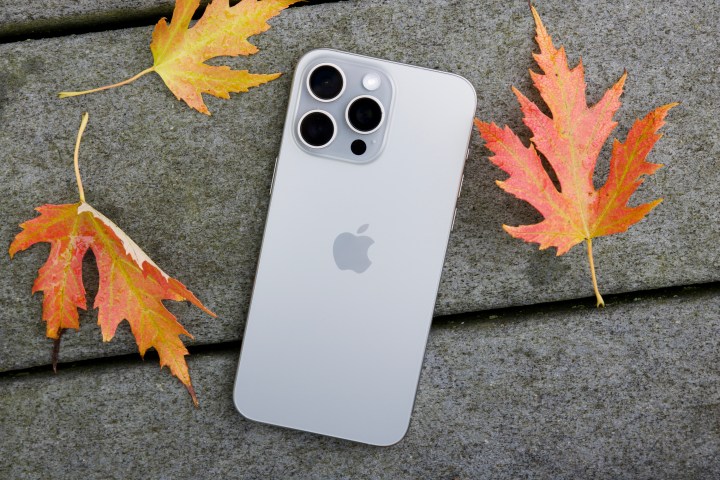
Joe Maring / Digital Trends
iPhone 15 Pro Max
The best iPhone camera
Pros
- Titanium design is a huge upgrade
- The Action button is excellent
- Outstanding camera system
- Virtually perfect display
- Blazing-fast performance
- iOS 17 is great (especially StandBy)
- USB-C port is convenient
Cons
- Slow USB-C charging speeds
- Only one way to use the Action button
- Disappointing battery life
Why you should buy this: The new tetraprism telephoto lens provides up to 5x optical zoom, and the resulting images are fantastic.
Who it’s for: Those who want the absolute best cameras on an iPhone and can deal with a large phone size.
The iPhone 15 Pro Max is the same as the iPhone 15 Pro — with a few key differences. You’ll still have the incredible new titanium frame, Action button, USB-C charging, A17 Pro chip with 8GB RAM, and 120Hz ProMotion display.
But the iPhone 15 Pro Max goes bigger with a 6.7-inch display, a slightly larger battery, and the all-new tetraprism telephoto lens that is capable of 5x optical zoom. If you want the absolute best camera on an iPhone, this is the way to go — as long as you can tolerate a large phone.
The 48MP main shooter and 12MP ultrawide still take great photos, just like on the iPhone 15 Pro. With 24MP photos by default, a lot more detail is captured in each image, and the Smart HDR 5 helps with keeping accurate and realistic colors and skin tones. Lowlight photos are also improved over last year, and Auto Portrait is a fantastic new feature, especially for parents.
But the tetraprism telephoto lens is where it’s at with the iPhone 15 Pro. If you want even more optical range, the iPhone is still beat by the Samsung Galaxy S23 Ultra with its 10x optical zoom. The iPhone 15 Pro Max’s 5x optical zoom is really impressive. Getting 5x closer to your subject while still retaining plenty of detail and color makes it better than the iPhone 15 Pro.

iPhone 15 Pro Max
The best iPhone camera
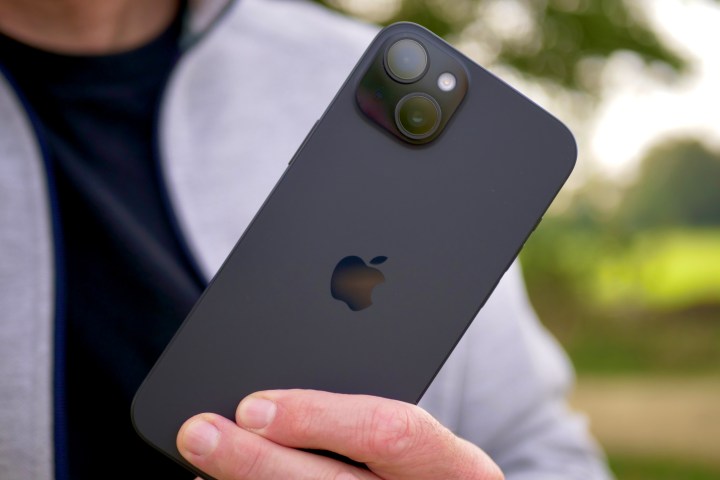
Andy Boxall / Digital Trends
iPhone 15 Plus
The best big iPhone
Pros
- Ergonomic design
- Big, bright, colorful screen
- Inspiring camera
- Two-day battery life
- USB C and MagSafe for charging
Cons
- 60Hz refresh rate screen
- No always-on display
- Not the latest processor
Why you should buy this: The iPhone 15 Plus is a big surprise with two-day battery life and plenty of other great features.
Who it’s for: Those who want a large iPhone that can last more than a day while still having most of the new features.
The iPhone 15 Plus is like the regular iPhone 15, but you know, bigger. It has a larger 6.7-inch Super Retina XDR display rather than 6.1-inches. Though the resolution is slightly bigger, the pixel density is the same. The larger screen is great if you want to display more on the screen at once. The iPhone 15 Plus also has the new frosted, color-infused glass back that has a nice matte finish, as well as curvier edges for a more ergonomic feel in hand.
Despite the iPhone 15 Plus still only having a 60Hz refresh rate on the display, it’s actually surprisingly smooth, and definitely an improvement over the previous iPhone 14 Plus. The rest of the display is still beautiful too, with bright and vivid colors and clear text.
As far as cameras, you still have a 48MP main camera and 12MP ultrawide, as well as a new ability to take 2x optical zoom telephoto shots despite not having a dedicated telephoto camera. Smart HDR 5, as well as the Photonic Engine and Deep Fusion, really help make the photos you take look great this year, instead of the harsh colors and blown-out skies from before. And the Auto Portrait feature is here too, making it easy to turn any photo featuring a person or pet into a portrait.
You have the A16 Bionic in the iPhone 15 Plus, as well as 6GB RAM. This is plenty of power for iOS 17, and therearen’t any problematic stuttering or performance issues. And combined with the large battery, the iPhone 15 Plus is a beast. This is an iPhone that can easily last about two full days on a single charge, which is great for those who don’t want to worry about charging. And with USB-C, you will get the same 50% charge in 30 minutes as before.
If you want a large iPhone that has a lot of endurance, and don’t need the fancy bells and whistles of the iPhone 15 Pro Max, then the iPhone 15 Plus is a great option.

iPhone 15 Plus
The best big iPhone
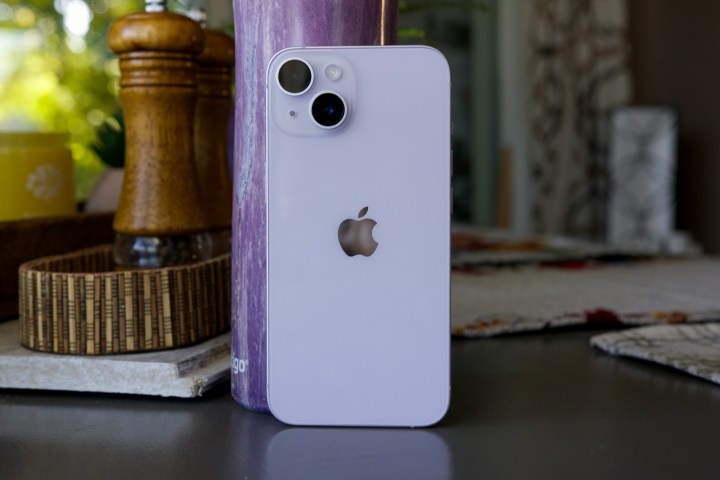
Joe Maring/Digital Trends
iPhone 14
The best value iPhone
Pros
- Comfortable, high-end build
- OLED screen looks fantastic
- A15 chip performs great
- Good camera upgrades
- Dependable battery life
- Helpful safety features
Cons
- 60Hz display
- No telephoto camera
- eSIM might be a pain for some
Why you should buy this: You want a solid iPhone without having to pay too much.
Who it’s for: Those who want to get some good bang for their buck.
The iPhone 14 may not be a super-exciting new upgrade for most techies, and it may also be a year old now, but for those who are coming from an older device, it’s still great. If you don’t need a 48-megapixel camera and an always-on display, and don’t care about the possibilities of the Dynamic Island, then the iPhone 14 is for you.
The iPhone 14 is actually still using the A15 Bionic from 2021, which was a slightly unusual move for Apple. However, that chip is still plenty powerful and certainly nothing to scoff at, and it’s also the slightly better version that was used in the iPhone 13 Pro. If you’re coming from anything older than the iPhone 13, the A15 will give you a noticeable bump in performance and speed for your everyday tasks.
The notch is still present on the iPhone 14, and the camera is just a slight improvement over the previous generation’s. There’s no always-on display, no Dynamic Island, and no 120Hz ProMotion display. However, you do get Apple’s new safety features on the iPhone 14, including Emergency SOS via satellite and crash detection.
So, while the iPhone 14 is not much different from the iPhone 13 before it, if you want the new safety features for some peace of mind, then grab the iPhone 14. Plus, the price is also less than that of the new iPhone 15 models, so you can get those features (and still a great camera) without having to cough up more dough for the latest and greatest.

iPhone 14
The best value iPhone
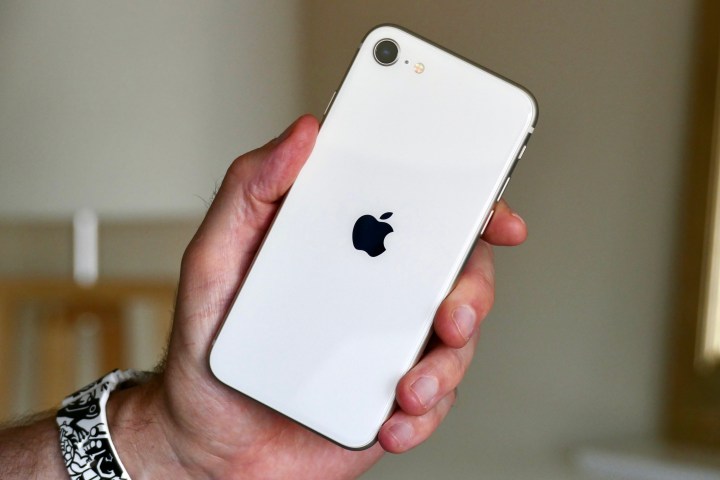
Andy Boxall/Digital Trends / Digital Trends
iPhone SE (2022)
The best small iPhone
Pros
- Compact and light
- Very powerful
- Touch ID works really well
- Wireless charging
- IP67 water resistance
Cons
- Poor battery life
- 60Hz screen
- 64GB won’t be enough
Why you should buy this: If you are looking for an iPhone that is smaller than 6.1-inches, then this is the one to get. It also has some pretty decent features.
Who it’s for: You want the most compact iPhone there is.
Apple’s iPhone SE (2022) starts at $429, making it the cheapest brand new iPhone you can buy at the moment. Yes, it has its limitations, but for the money, it’s a great little smartphone, with an emphasis on the little — it’s the smallest iPhone that Apple currently offers.
The iPhone 8 design is dated and chunky, but you get the same tough glass used on the iPhone 13 (minus Ceramic Shield). It’s also compact enough for one-handed use and a great choice for those who prefer a smaller phone.
Under the hood, you get Apple’s A15 Bionic chip, the same found in the iPhone 13 and iPhone 14, plus 4GB of RAM and 64GB, 128GB, or 256GB of onboard storage. There’s also a bigger battery than its predecessor, so you should be good to go all day without recharging.
The 4.7-inch Liquid Retina Display boasts 1334 x 750 resolution (around 326 pixels per inch) and a 60Hz refresh rate, ensuring everything looks crisp, plus there are other goodies like True Tone technology, haptic touch, and wide color support. Yes, it’s a small screen, but it’s still impressive. You also get a single-lens 12MP camera on the rear and a 7MP selfie camera, both of which perform well, provided lighting conditions are good. uUnfortunately, there’s no Night mode. You also don’t get Face ID, though the Touch ID fingerprint sensor is very reliable.
The latest iPhone SE packs 5G, making it an excellent future-proof choice. Only sub-6GHz (and C-Band) 5G are supported, but this is still a big upgrade over 4G in terms of speed, provided you live in an area where 5G is available.
For those who play a lot of the latest, most demanding games or watch a lot of videos, the new iPhone SE (2022) might not be the right choice. It might also not be right for you if you take most of your photos after dark or in poor lighting, due to the lack of Night mode. Otherwise, if you want the smallest iPhone with a powerful processor, plenty of onboard storage, and a stunning display, without breaking the bank, there’s no better way to get these things than with the iPhone SE (2022).

iPhone SE (2022)
The best small iPhone
Frequently Asked Questions
How much storage should I get?
A dilemma that always pops up when buying a new iPhone is deciding on what storage size to get since the iPhone does not have expandable storage. This all really depends on what you plan on using your iPhone for.
If you mostly stream music and video content, don’t take a ton of photos or videos, don’t download a lot of big files, and don’t plan on playing a lot of graphically intensive games like Call of Duty: Mobile and Diablo Immortal, then you could probably get by with the base storage. All iPhones in this guide start at 128GB of storage, except the iPhone SE, which begins at 64GB. A lot of people use cloud storage solutions to keep their data backed up, so the reliance on local storage on an iPhone is not as big of a deal as it was before.
For most people, though, 64GB, or even 128GB, just isn’t enough. Maybe you plan to use the great iPhone cameras to take a lot of photos and videos of your loved ones, or you just like taking pictures of everything. You may occasionally want to download television shows or movies to watch offline, or perhaps you want to land some headshots in Call of Duty: Mobile in your downtime. If that’s the case, then opting for 256GB or 512GB is a safe bet that gives you more leeway.
And for those who just take photos and videos of everything and never want to delete files off of their device, have a ton of apps and games, and want to download albums or videos for offline viewing, then 1TB is the way to go. However, if you want 1TB of storage so you never have to worry about running out of storage space again, then you’ll have to go for either the iPhone 15 Pro or iPhone 15 Pro Max, as those are the only devices that offer this storage size.
Apple does have its own iCloud service for online storage, but you only get 5GB for free, which is hardly anything these days. You can get more storage, but only if you pay for it. The cheapest option is 50GB for $1 per month, or your can go to 200GB for $3 a month, or 2TB for $10 a month. And iCloud storage is also included in Apple One bundles, which also encompass other Apple services like Apple Music, Apple News+, Apple TV+, Apple Arcade, Apple Fitness+, though what you get depends on the tier you choose.
How long will I get updates?
All of the iPhones mentioned here include 5G connectivity, so they’re all going to be pretty future-proof, including the iPhone SE. And as far as software updates go, Apple is pretty good about making sure that you get several years of updates for your iPhone.
In addition, iOS 17 currently works on devices going back to the iPhone XR, which came out in 2018. That’s at least five years of updates! So if you buy one of these iPhones right now, you should be guaranteed to get support for a similar amount of time.
What if I’m switching from an Android device, or what if I want to leave the Apple ecosystem later?
If you’re coming to an iPhone from an Android phone, remember some data may not easily transfer over, and you will have to get used to a new software operating system. For example, data saved in some messaging apps (WhatsApp, for example) can be difficult to export or import, so you may have to start with a clean slate. While iOS is logical and easy to use, it will feel different, so expect a learning curve before it feels like home.
Finally, once you’re inside the Apple ecosystem, it can be difficult to escape. Many accessories are Apple-only, apps you purchase can’t be swapped to Android or vice versa, and if you buy an Apple Watch Series 8 or Apple Watch Ultra — which we recommend if you want a smartwatch — then it only works with an iPhone. Provided you understand the commitment you’ll be making for the next two years minimum, an iPhone will serve you so well that you may not want to switch to another brand at all.
Why should you trust our recommendations?
We have reviewed iPhone models since the very beginning, along with almost every major Android smartphone too. When we try out a phone, we live with it every day, mostly as our only smartphone, to see how it performs the tasks we all need it to on a daily basis. This way, we get to see where it excels, and also where it may fail. Then we tell you all about it.
For that reason, we can make educated recommendations on which phones are worth it. In addition to the expense, buying one of these phones means committing to one phone for up to two years, should you buy it with a contract through a carrier. You need to make sure the decision is the right one, and being as informed as possible ahead of laying down your money is sensible.
We’re confident that buying an iPhone is one of the best decisions you can make in the smartphone market, based on our experience, and the models above are the ones that deserve your attention.
Editors’ Recommendations

